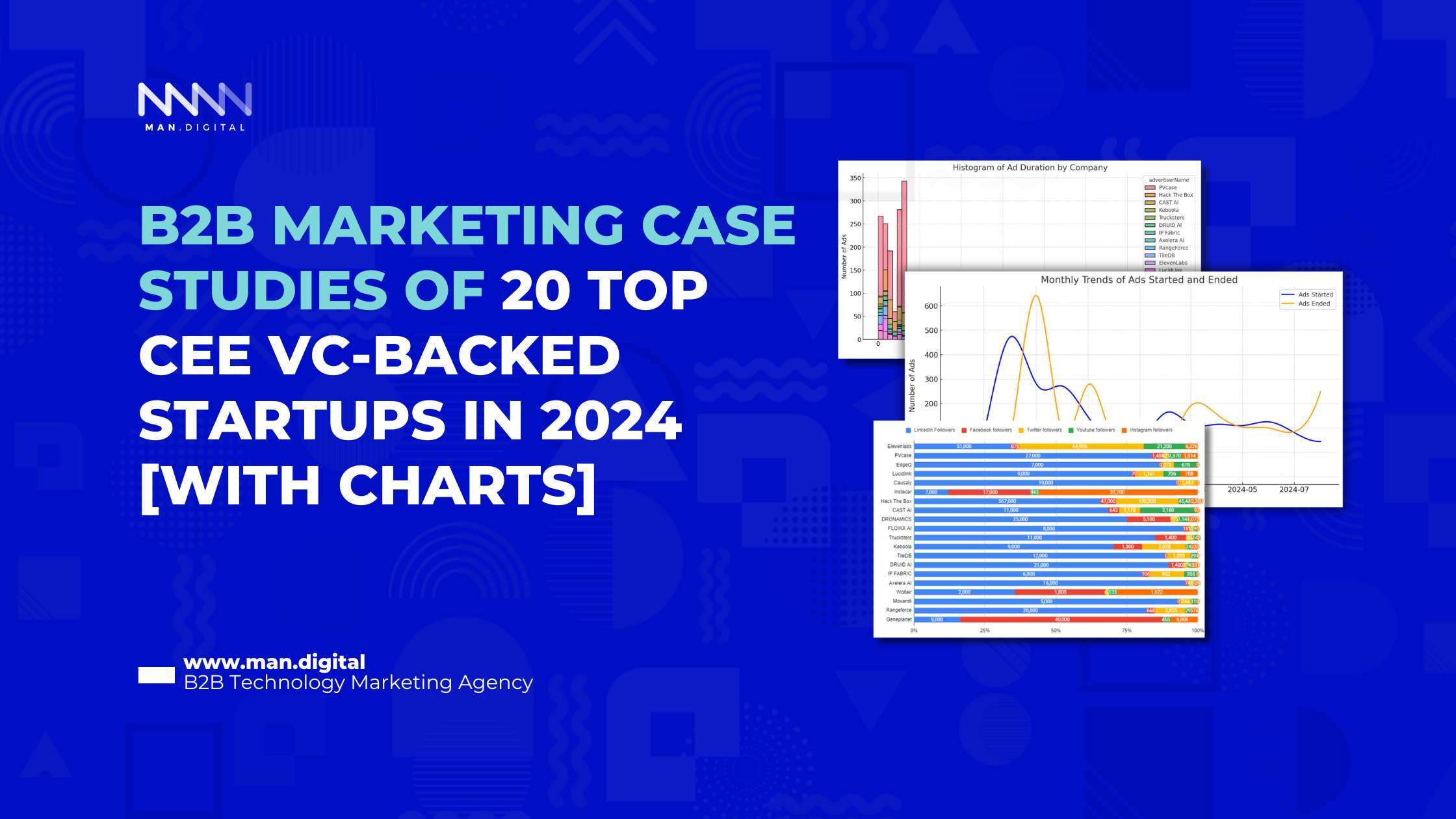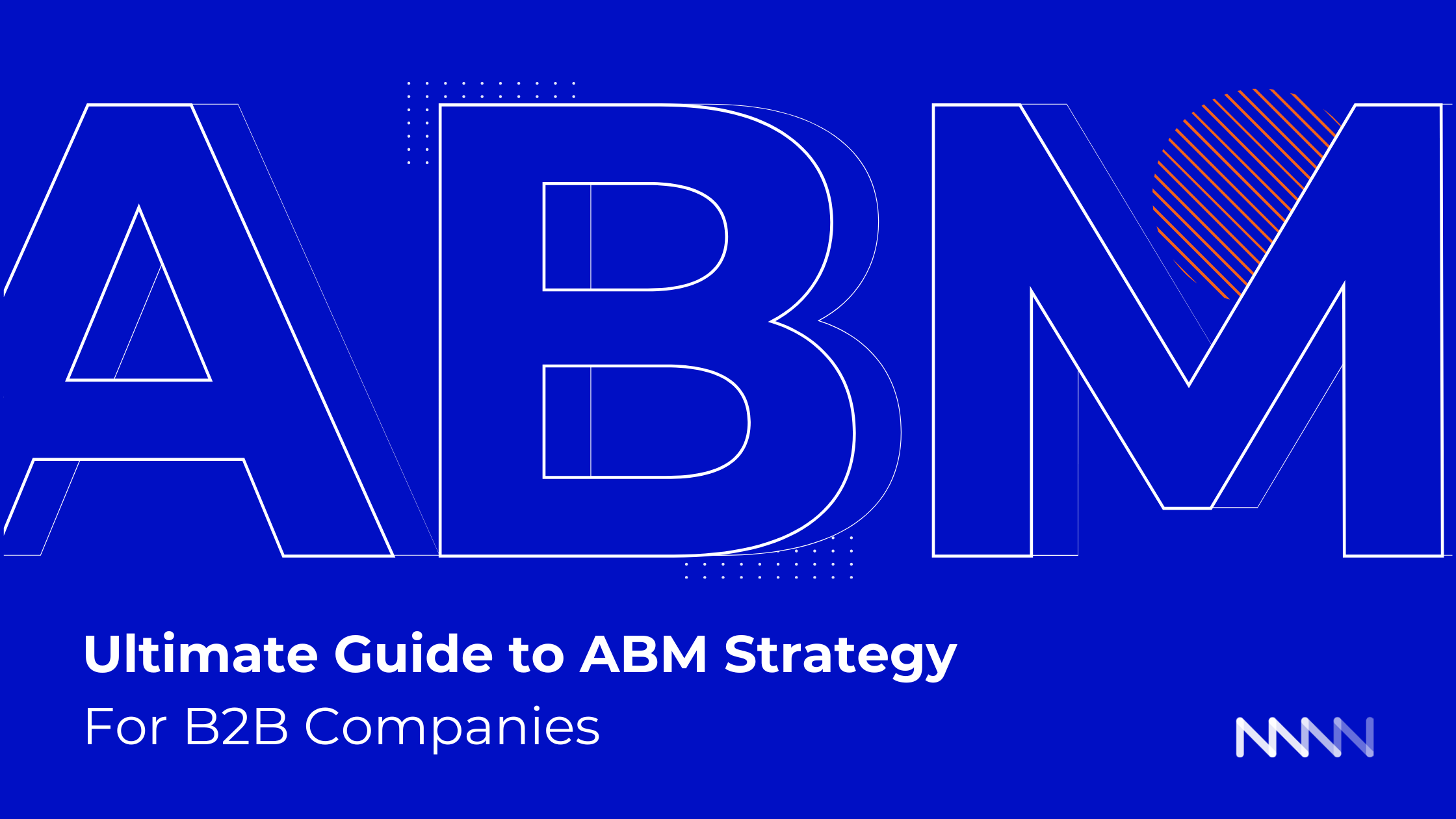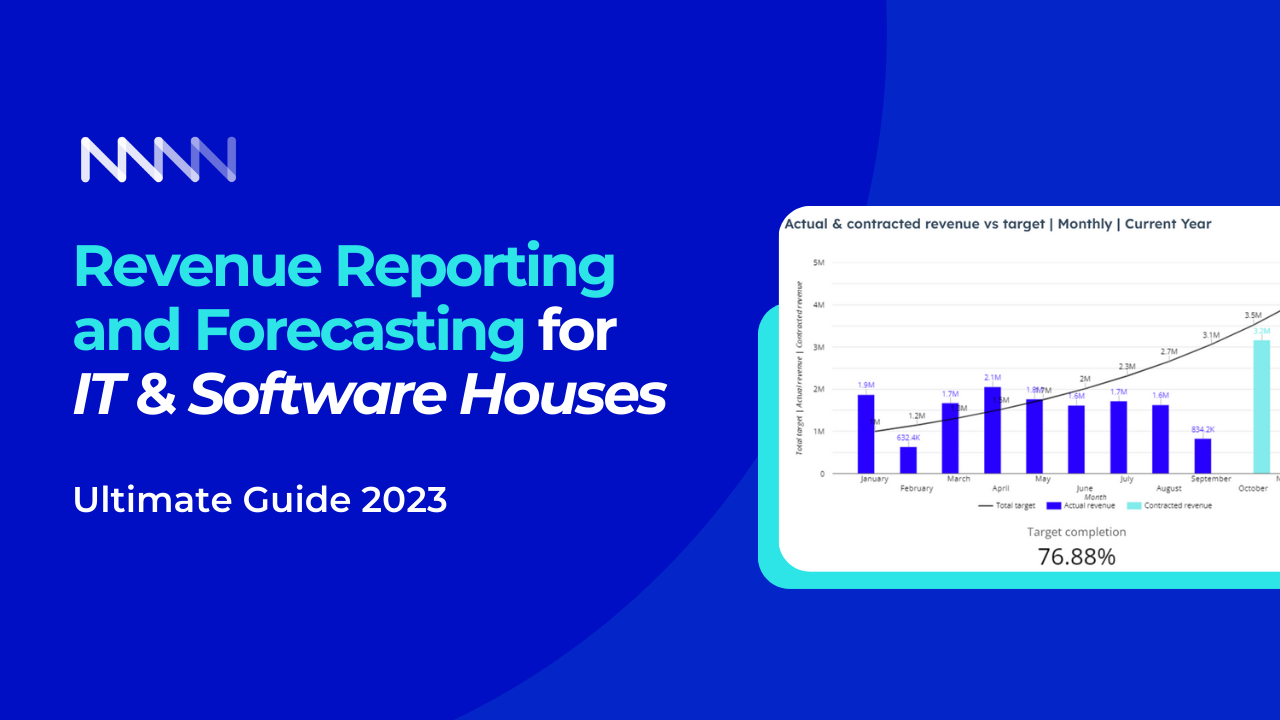GUIDE: Hands-on Tech Stack for Account-Based Programs Using HubSpot
With the rise of account-based marketing, marketers need to be focused on how they can bring operational excellence and fix broken lead models.
This is where HubSpot comes in. HubSpot allows you to easily integrate with a variety of tools and track your marketing efforts, so you can measure success and optimize for future campaigns.
In this blog post we will explore HubSpot's ABM features, some essential HubSpot integrations, common attribution problems and fixes, profiles of Marketing Operations Specialists who work at HubSpot, what should be measured and how to do real-time personalization using HubSpot CMS for ABM programs? And more!
Table of Contents
Marketing is changing.
The old way of marketing was to reach out to as many people as possible and hope that some would convert. This is why marketers are now shifting their focus from "reach" to "conversion."
The solution is in account - based programs and, as Bev Burgess puts it in her book "Practical Guide to Account-Based Marketing (ABM)", we can group the ABM tech stack into four main categories.
- marketing infrastructure
- account insights
- client engagement
- campaign management
Marketing strategies are fragile, in this article we try to show you how to make them more resistant to Google or LinkedIn changes.

HubSpot covers all four to some extent (not completely - but enough for getting started with ABM Lite). In this blog post we will share with you the frameworks, Google Slides we use with clients, webinars we run on the topic of tech stack with HubSpot, and some nice nuggets from our experts we invited to talk about the topic.
Tech Stack Maturity Plan & Challenges.
So we'll start with the fundamentals of the foundations for HubSpot and infrastructure. Then we'll get into the nitty-gritty of ABM since we think it's essential to begin with the foundations for general stack and marketing and sales alignment, and then consider the ABM later on.
The utter amount of marketing possibilities poses both an opportunity and a difficulty for ABM. As Scott Brinker writes on chiefmartec.com there are now over 8000 solutions in the marketing technology landscape.
 How do you cope with the hub-and-spoke architecture and how to get your hands on all of these tools?
How do you cope with the hub-and-spoke architecture and how to get your hands on all of these tools?
From our observations while implementing HubSpot in several B2B businesses, we've identified that companies go through three phases before achieving operational excellence. These are:
- Chaos
- Efficiency
- Growth
Stage 1 - Chaos in your CRM
You're getting your feet wet in the first six months, it was a chaos in you CRM, which is perfectly normal. Most probably, you encountered the following:
- Unclear lead-flow
- Marketing & sales processes are not aligned.
- Data is there but not accurate.
- You measure too much data, focusing on vanity metrics.
- Success metrics are unknown and not tracked.
- Tracking contacts and leads instead of companies.

To get out of this chaos, you will need a clear strategy for your audience.
Data is there, but it's not actually accurate. You're probably focusing on vanity metrics like page views and clicks, rather than the more important success metrics. And then the other thing that we see is that the lead-generation comes a little from B2C angle, where leads are the main metric, in B2B, we mostly care about the companies.
So this is the first problem that most of the systems are actually built around contacts, not the companies.
Stage 2 - Your Start to build efficiency with your marketing technology
First, when you're working on a plan to tackle the issue, you have your strategy and procedures in place, but people don't yet use them. You've implemented all of this, but you can't trust the data.
Ugh... it's a huge struggle to forecast to set the goals and track it because data is a bit flowing.
Stage 3 - Growing your marketing and sales capabilities
Now you start thinking about getting more insights and growing with the infrastructure.
The majority of the businesses are in this period between month 6 and month 12. The following are the obstacles you'll encounter at this point:
- Marketing and sales are not filling in the data
- There is no data integrity monitoring process
- SLAs are not fulfilled
- Automations are not reliable or lacking
- Infrastructure is not used to its full potential
- There is no consistency in reporting and reacting
- It is a struggle to forecast, set and track goal
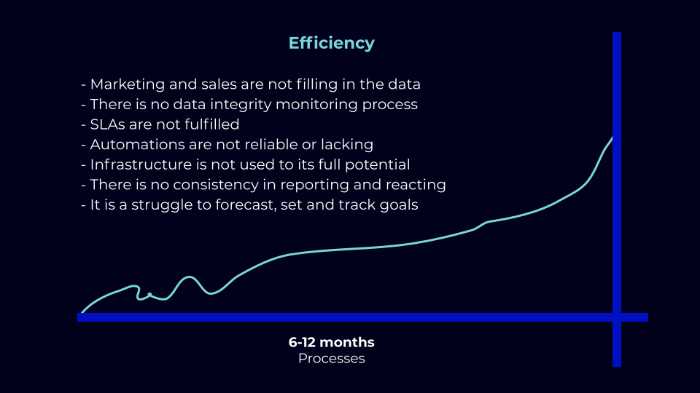
By now, you've decided which technologies you'll use. But if this is your first time implementing a tech stack or adding another technology to it, you might feel overwhelmed. The building process is key at this stage.
After a year, your management will want you to transition into the growth stage, and here are some additional difficulties:
- Attribution turns out to be harder than we thought.
- We are facing functionalities limitations.
- There is a need for additional integration.
- Our messaging is not relevant and we are spamming.
- A full cycle experience is hard.
- Controlling large teams ain’t easy to keeping things in order.
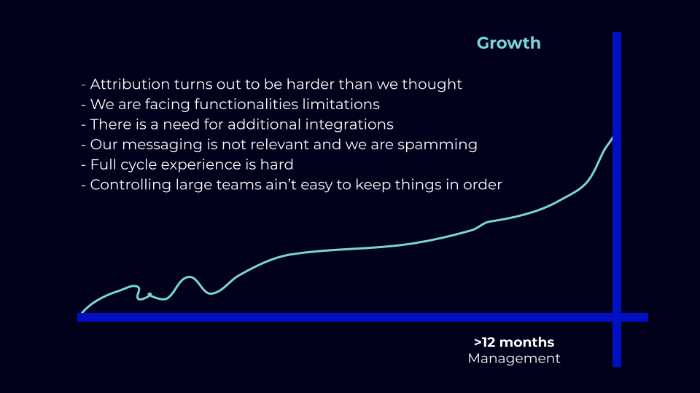
In conclusion, the biggest challenge we see with businesses when implementing a revenue infrastructure is that companies are "sold" by market tech ideology, where businesses start to build so - called "funnels" when B2B buying is not at all a funnel but rather a set of complex touch points and engagements with different stakeholders in the buying process.
Here is a nice illustration from Gartner about the complexity of the buying process.
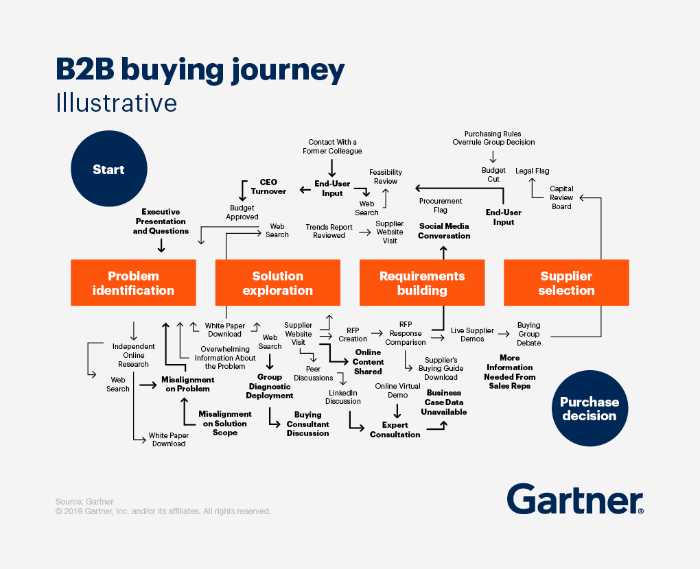
Yeah, I know. If it were easy. We would be all millionaires.
Worry not! We can make it easier to succeed with strategy, process and frameworks. Lucky you, for reading this article :)
Let's continue with account-based programs and how you can embed it in HubSpot.
How to Embed ABM in HubSpot?
In the next section of this blog posts I'll explain how to embed account based programs in HubSpot.
It shouldn't be so hard!
With HubSpot, you can easily connect your CRM data with marketing automation workflows that are designed specifically for B2B companies using Account Based Marketing (ABM).
This allows you to personalize every single message based on who reads it while also tracking their interactions with these messages through an ABM reporting dashboard. And because everything is connected together, there’ concise and clear.
Before jumping into this, here is a recap on what is account-based marketing?
Account-Based Marketing is a strategic approach that coordinates personalized marketing and sales efforts to open doors and deepen engagement with specific accounts.
One of the benefits of account-based marketing is that the marketing and sales department work on the same account. That makes sense, but now there is a HUB to include all the different touchpoints at an affordable price.
ABM is starting to be affordable with HubSpot :). Yuppie
Although, hold your horses when it comes to attribution, there is the "dark social". Let me explain this in the next slides.
What is the "dark social" in B2B, and why is it important to understand it for your B2B marketing and sales?
 The dark social is the content, links and ads that are shared across personal social media accounts, information about your company, content and posts that are hard to track and attribute in your HubSpot.
The dark social is the content, links and ads that are shared across personal social media accounts, information about your company, content and posts that are hard to track and attribute in your HubSpot.
Here is a short snippet from our webinar, where Patryk explains the dark social in 1 min.
Also a full podcast episode on the topic from Chris Walker you can find here.(explicit language warning)
Many organization leaders (technical profiles) will expect you to attribute revenue of your organization to a channel.
This will be hard.
Mainly because the behaviour of people has changed a lot and technology cannot keep up with cross - device tracking. Additionally, we have companies like Apple that limit third party tracking.
Although it's hard to track, you should try and understand the impact of this "dark social" in your organization because very likely that people are sharing information about your company across their personal accounts. So they might be talking about good things or bad... We all know how humans work ;).
Now that we have covered the dark, let's go back to our main topic, HubSpot and account based marketing.
STEP 1 - Start using "targeted accounts", account tiers, and buying roles in HubSpot.
With HubSpot sales professional, you can use the targeted accounts feature. This enables you to create a list of accounts that are prioritized for sales.
Targeted Accounts in ABM are a list of companies marketing and sales will target to close more deals. Account Tiers are groups within accounts prioritized based on similar characteristics and buying behaviours. (i.e. company size, technographics, firmographics, etc)
Account Tiers are groups within accounts prioritized based on similar characteristics and buying behaviours. (i.e. company size, technographics, firmographics, etc)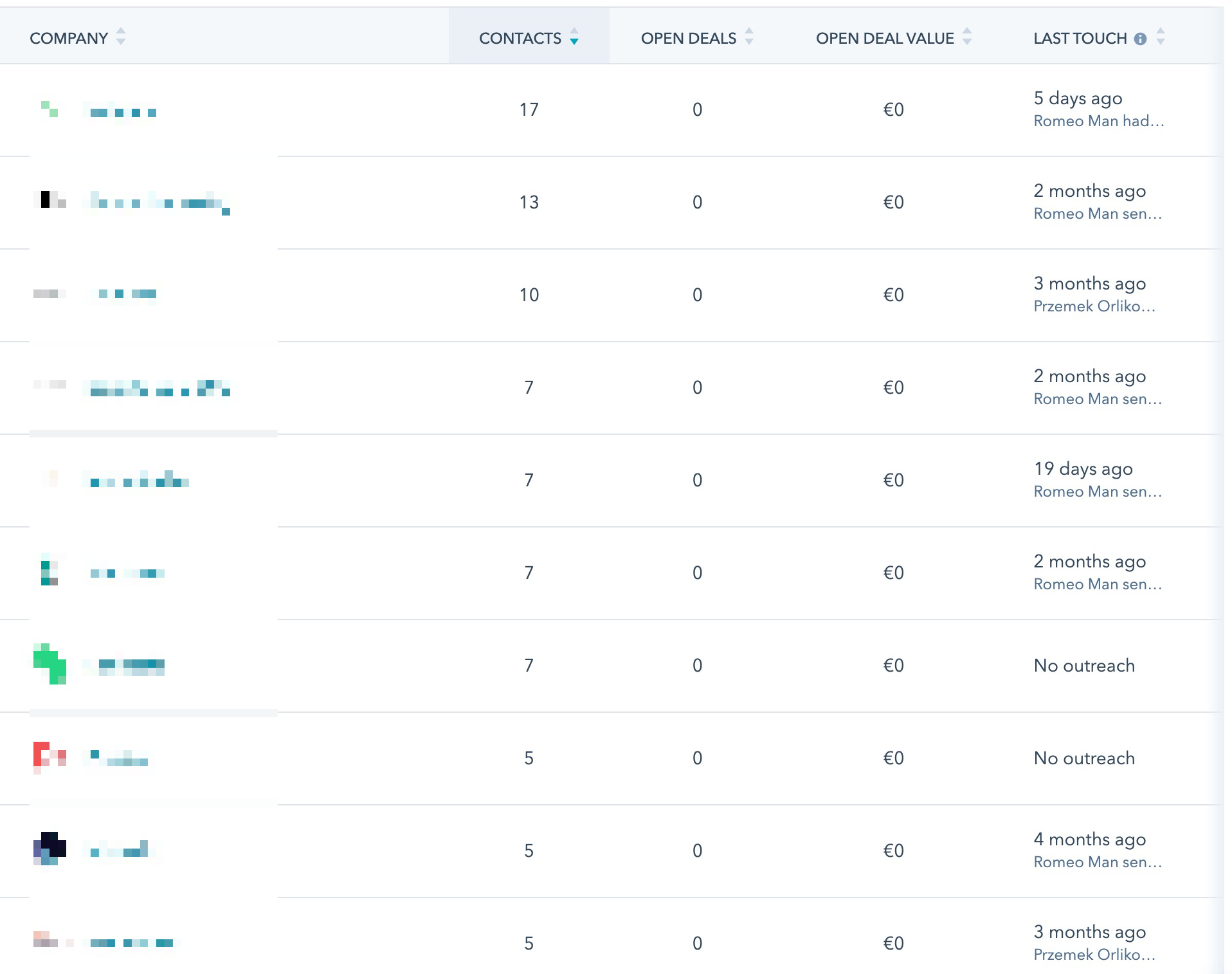
Buying roles identifies the position that a contact plays throughout the sales process. Options for the property are decision maker, budget holder, influencer, blocker.
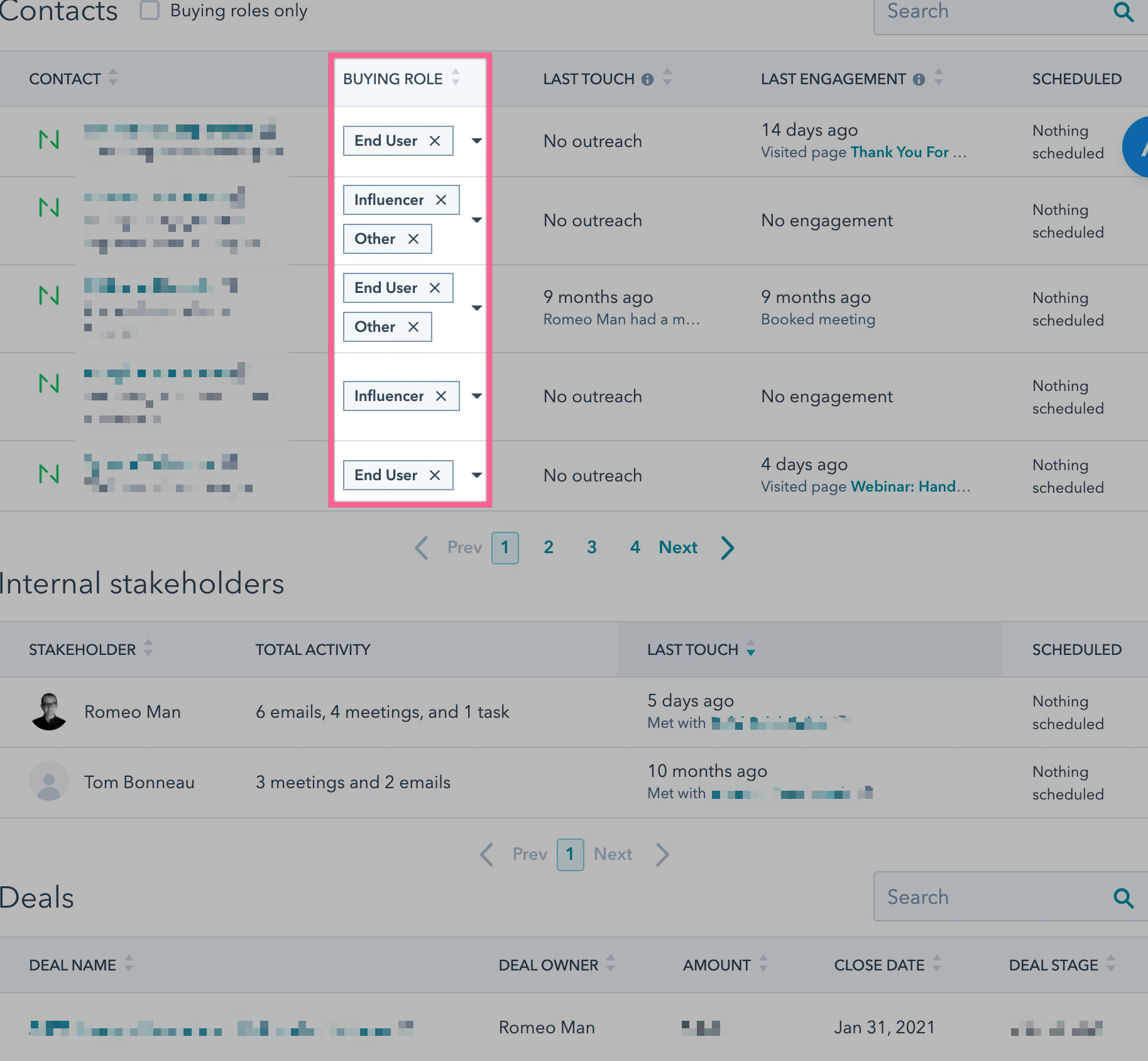
Adding, as well as developing personas, will further enhance your strategy because you'll know the buying roles' responsibilities
Then, with HubSpot marketing, you can start adding these elements to your workflows to personalize every piece of content or advertising message sent via email or social media according to their profile and stage they are at.
Mind bomb 💣
STEP 2 - Fixing your Lifecycle Stage & Lead Status inside HubSpot
The first step is to fix your lifecycle status & lead status framework, and this, so you can:
- report on your results more efficiently
- know what is actionable in your accounts.
We've created in MAN Digital a framework mixing of the "The Measurable Lead Model" by Marko Savic, Director Product at Varicent and the Lifecycle by HubSpot.
Here is the model 👇
Clearing this out will help us create reporting.
STEP 3 - Build ABM reporting inside HubSpot
Yes, it is possible to create ABM reporting inside HubSpot.
The first thing you need to do here is asking "how does this report align with my organization's business goals?"
HubSpot has some out of the box solutions for ABM reporting, These include:
- No. of Idea Customer Profiles per tier
- Contacts created at targeted accounts monthly.
- Targeted accounts by page views.
- Buying role by targeted accounts.
- Contact source by target account
- Contact lifecycle by targeted account
- Deal stage by targeted account (second favourite)
- Targeted account by active deal amount (my favourite) - what matters for most businesses.
Example of ABM Dashboards we use internaly.
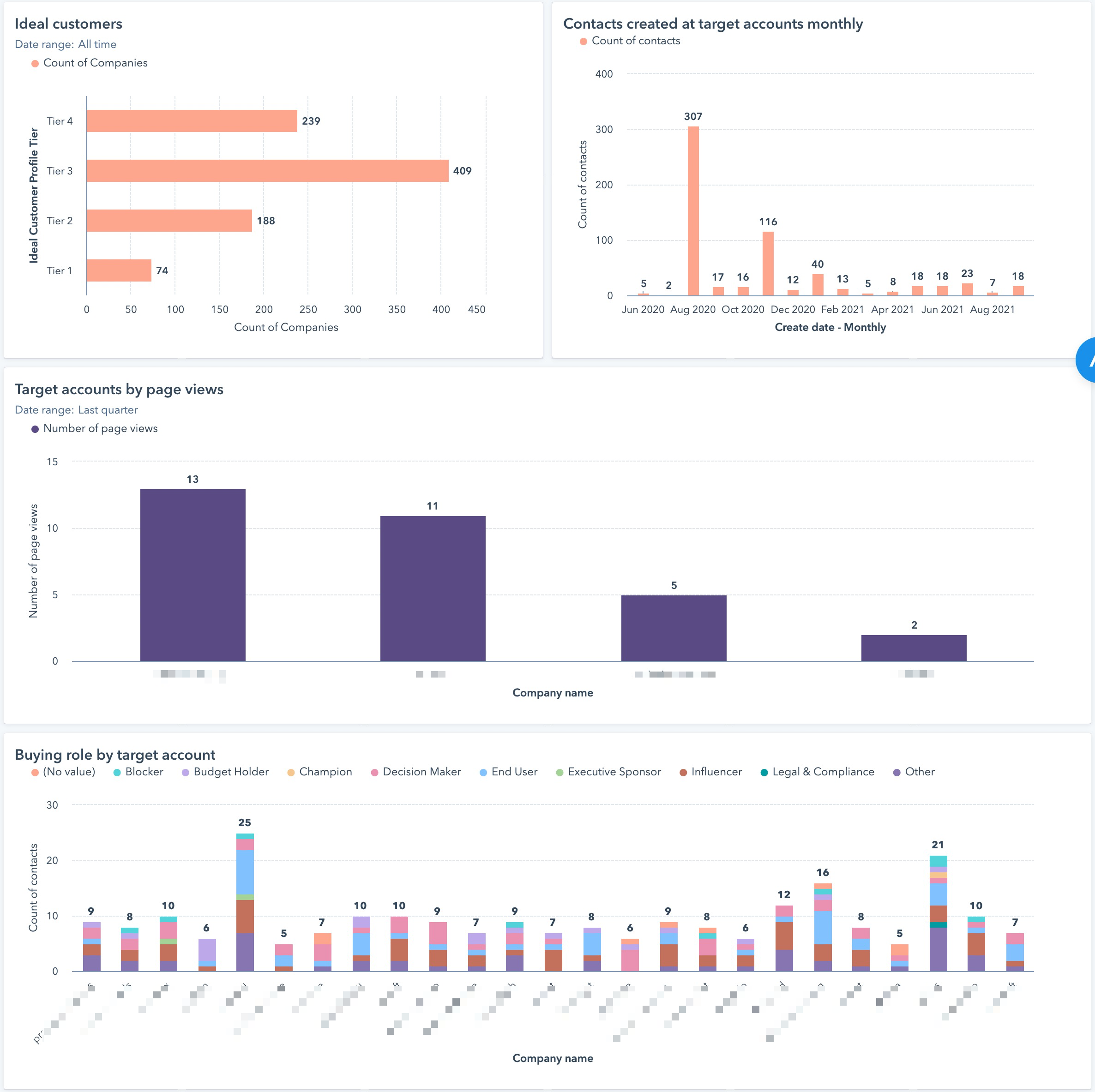
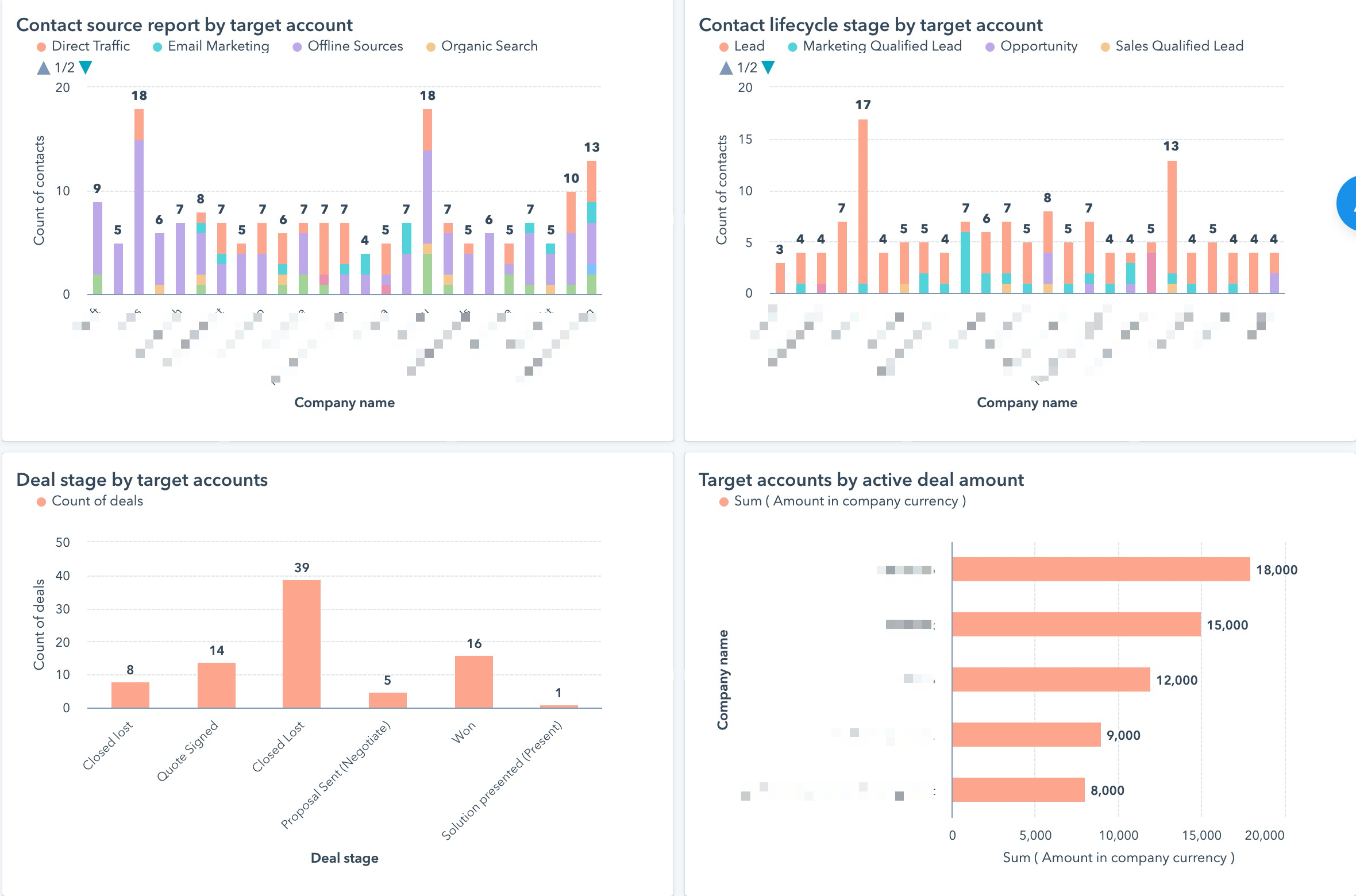
If you can report the above to your executive board, you are way ahead of many other companies. These reports to your hub and you are ready for ABM reporting.
The next dashboards are custom built by Przemek from our team.
Adding to this, it is good to know the generated pipeline volume per targeted account.
Understanding what kind of contacts we attract with our ABM programs.
What about interactions?
HubSpot allows us to see which tiers we engage with most frequently. This dashboard is a good illustration of how HubSpot ABM capabilities and "The Measurable Lead Model" by Marko Savic are integrated.
Who are the businesses that have looked up our website and are currently researching?

What content brings big accounts? (tier 1) - This is great news, as we now know exactly what type of material we should write about. Additionally, to this, you can also add the no. of submissions per accounts.

Understand the sales cycle per each segment and per quarter.
Now you know what content to create for what audience and how this influences your sales cycle. Now, do that without HubSpot and ABM. A bit hard no?
The objective here is to bring clarity to your business. Let's move now to some optional integrations (we) use.
STEP 4 - Sales Intelligence integrations to equip engagement programs.
We add Albacross to better understand who are the companies that visited our website but didn't convert. Albacross is our favourite tool for doing this. Here is a webinar I did with Marcus, going a bit more into detail on how to use it.
In a nutshell, I know when my competition visits my website what kind of information hot prospects look for and how new prospects get on the website.

Agnieszka from our team goes through the list daily and notifies (Slack Channel) us of whom the companies are and if we should pick it up and start engagement programs.
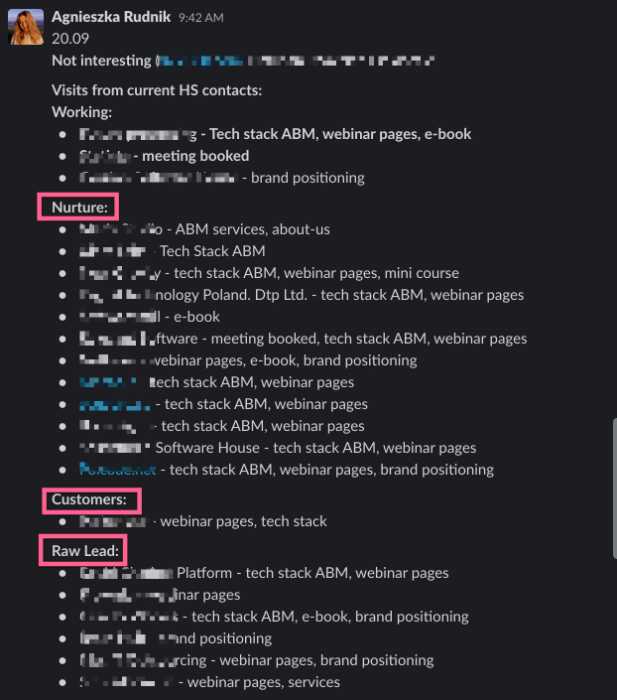
In this case, sales just needs to pick up the conversations with relevant hot leads.
STEP 5 - Personalize your website for your targeted accounts and buying committee in real time (optional).
This is where it gets interesting... With HubSpot CMS, you will be able to personalize the content in real time for specific target accounts, so you can send a different message, using the same URL.
Imagine targeting different buying roles differently, here is an example of how we target decision makers (CEO's) of software houses by delivering different messaging.
Here are some examples.
Personalize the headline based on the company's industry.
All companies:
Software Houses:
Now, let me show you how you can personalize even more and not be creepy at all.
Now, lets combine CEO's and industry (software houses)
We make a list with all contacts that are CEO's and from Software Houses
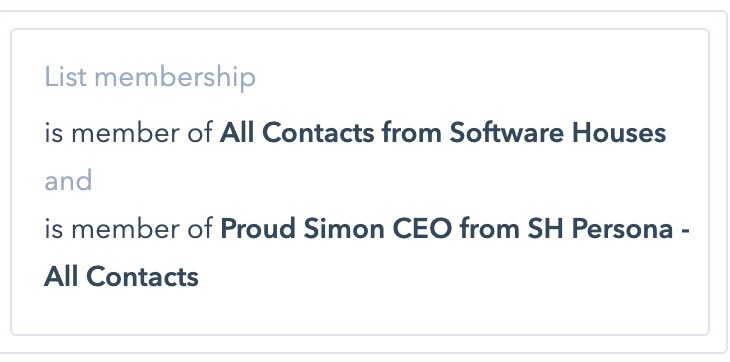
Smart content rule setup:
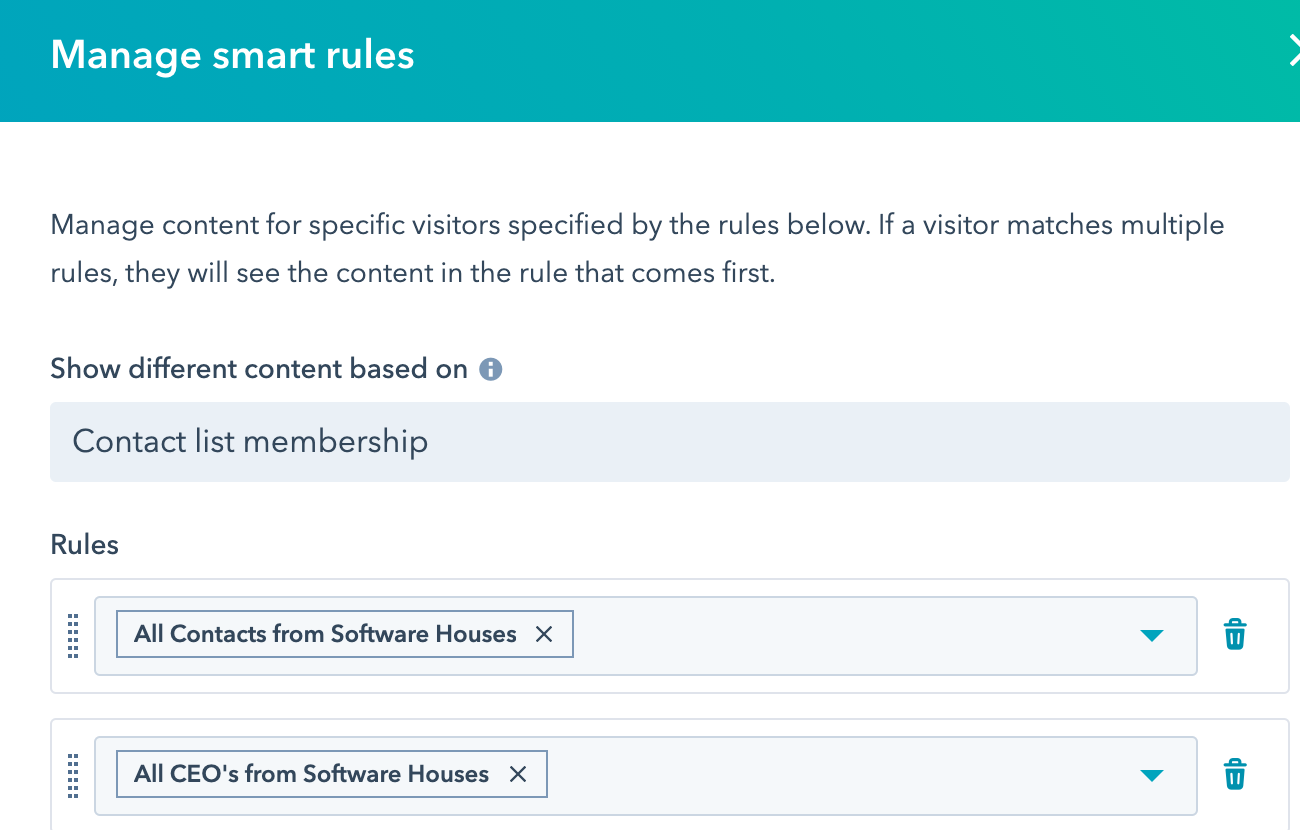
Content Personalization "Headline Copy" and "Subheadline copy"
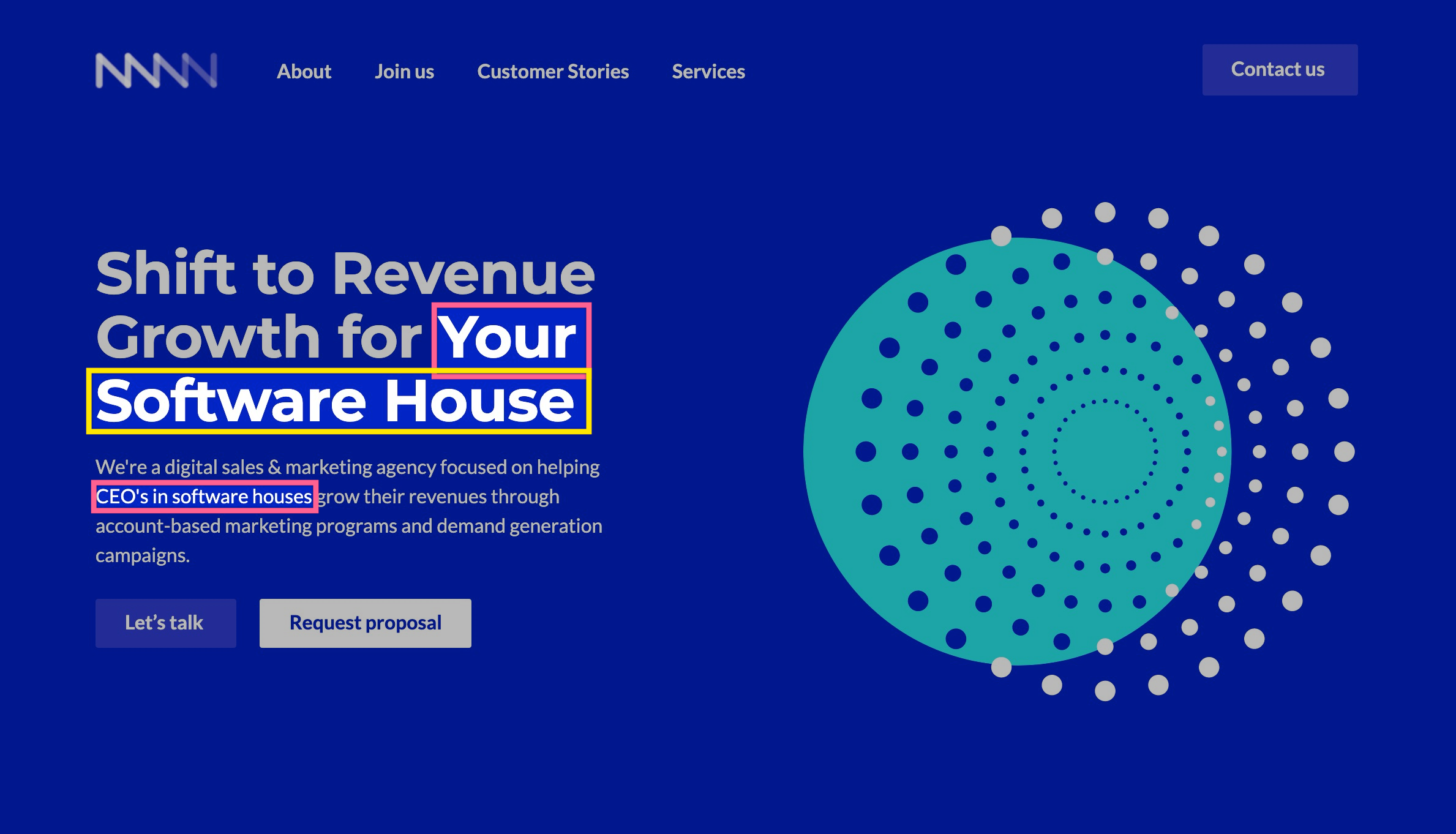
and that is just the is a "drop the mic moment".

Imagine changing portfolio clients logos based on who is visiting the website. Or, recommend some content on your resources page only to some contacts.
Marketing Operations Specialist Profile To Put HubSpot ABM in Action
Look, I get it! It is not easy and it takes time. If you are committed to do this the ROI will be there.

However, who will put everything together?
The answer is simple. The MOPS (Marketing Operations Specialist). If you hire one make sure she/he is:
- Understands marketing and sales processes,
- Good communicator,
- Analytical mind,
- Reasonably technical
If it is hard to hire, we can do it :) - ha, I couldn't miss the moment not to write this. 😅 It was a perfect fit -haha
Conclusions and Additional Resources
We've covered a lot of ground in this blog post, and we hope you enjoyed it. If you want to learn more about any specific topic, please let us know! The best way for your marketing team to get the most out of HubSpot is by partnering with an experienced marketing operations specialist who can help you understand these new tools and processes.
In the end you need to choose your customer engagement path.

These specialists are knowledgeable in how marketing technology stacks need to evolve over time as they mature into efficiency-driven engines that drive growth. You can find some useful resources below if you would like additional information on our topics today. Happy listening!
Additional resources:
Webinar: Hands-on Tech Stack for Account-Based Programs Using HubSpot
Podcast episode version:
Webinar Slides:
Extra webinar on ABM with Netguru:
Webinar: Account-Based Marketing For Technology Businesses

